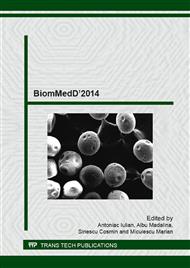[1]
N.A. Peppas, J.Z. Hilt, A. Khademhosseini, R. Langer, Hydrogels in Biology and Medicine: From Molecular Principles to Bionanotechnology, Adv. Mater. 18 (2006) 1345-1360.
DOI: 10.1002/adma.200501612
Google Scholar
[2]
N. Jain, P. K. Sharma, A. Banik, A. Gupta, V. Bhardwaj, Pharmaceutical and Biomedical Applications of Interpenetrating Polymer Network, Current Drug Therapy 6 (2011) 263-270.
DOI: 10.2174/157488511798109547
Google Scholar
[3]
R.P. Dumitriu, A.M. Oprea, I.E. Raschip, C. Vasile, In Environmentally Degradable Materials Based on Multicomponent Polymeric Systems, in: C. Vasile, G.E. Zaikov (Eds. ), Chapter 7, Brill Academic, The Netherlands, 2009, pp.250-335.
DOI: 10.1163/ej.9789004164109.i-654.70
Google Scholar
[4]
J. Malakar, A.K. Nayak, S. Goswami, Use of Response Surface Methodology in the Formulation and Optimization of Bisoprolol Fumarate Matrix Tablets for Sustained Drug Release, ISRN Pharm. 2012 (2012) 730624.
DOI: 10.5402/2012/730624
Google Scholar
[5]
Y.H. Yin, Y.J. Yang, H.B. Xu, Swelling behavior of hydrogels for colon-site drug delivery, J. Appl. Polym. Sci. 83 (2002), 2835–2842.
DOI: 10.1002/app.10259
Google Scholar
[6]
H. Almeida, M.H. Amaral, P. Lobão, Temperature and pH stimuli-responsive polymers and their applications in controlled and selfregulated drug delivery, Journal of Applied Pharmaceutical Science 2 (2012) 01-10.
Google Scholar
[7]
H.G. Schild, Poly(N-isopropylacrylamide): Experiment, theory and application, Prog. Polym. Sci. 17 (1992) 163–249.
Google Scholar
[8]
C. Vasile, R.P. Dumitriu, C.N. Cheaburu, A.M. Oprea, Architecture and composition influence on the properties of some smart polymeric materials designed as matrices in drug delivery systems. A comparative study, Appl. Surf. Sci. 256S (2009).
DOI: 10.1016/j.apsusc.2009.04.120
Google Scholar
[9]
Y.T. Dangat, N.A. Bari, S.C. Jagdale, A.R. Chabukswar, B.S. Kuchekar, Controlled release from bisoprolol fumarate buccal patches, Der Pharmacia Sinca 3 (2012) 317-320.
Google Scholar
[10]
A.C. Moffat, M.D. Osselton, B. Widdop, Clarkes's Analysis of Drugs and Poisons, third ed., Pharmaceutical Press, UK, (2005).
Google Scholar
[11]
T.G. Kantor, Ketoprofen: a review of its pharmacologic and clinical properties, Pharmacotherapy 6 (1986) 93-103.
Google Scholar
[12]
R.W. Korsmeyer, S.R. Lustig, N.A. Peppas, Solute and penetrant diffusion in swellable polymers. I. Mathematical modeling, J. Polym. Sci. Part B: Polym. Phys. 24 (1986) 395-408.
DOI: 10.1002/polb.1986.090240214
Google Scholar
[13]
P.L. Ritger, N.A. Peppas, A simple equation for description of solute release II. Fickian and anomalous release from swellable devices, J. Controlled Release 5 (1987) 37-42.
DOI: 10.1016/0168-3659(87)90035-6
Google Scholar


